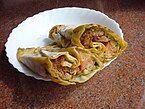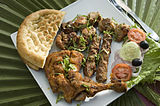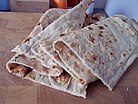ロティ
Roti/ja
 チャパティとして知られるフラットロティ | |
| Alternative names | Ruti |
|---|---|
| Type | フラットブレッド |
| Place of origin | インド亜大陸 |
| Created by | インダス文明 |
| Main ingredients | Atta flour/ja |
| Variations | チャパティ、バジュラ・ロティ、ジョワル・ロティ、チャワル・キ・ロティ、マッキ・キ・ロティ、ルマリ・ロティ、タンドーリ・ロティ、ラップ・ロティ、ロティ・チャナイ、パラタ |
ロティは、インド亜大陸発祥の丸い薄焼きパンである。これは、多くの南アジア、東南アジア、カリブ海、東アフリカ、東南アフリカ諸国で一般的に食されている。
これは石臼で挽いた全粒粉、インドではゲフ・カ・アタとして知られているものと、水を加えて生地にし、作られている。その決定的な特徴は、無発酵であることだ。対照的に、インド亜大陸のナンは、イーストで発酵させたパンであり、クルチャも同様だ。世界中のパンと同様に、ロティは他の料理に添えられる主食である。
語源
「ロティ」という言葉は、サンスクリット語の「roṭikā」に由来しており、「パン」を意味している。
種類
- マッキ・ロティ: トウモロコシ粉のロティ。サルソン・カ・サーグ(からし菜の煮込み)と共に供される、パンジャブの代表的な料理である。
- アッキ・ロティ: 米粉のロティ。すりおろした野菜とスパイスを加え、チャツネと共に供される、カルナータカ州で有名な料理である。
- タリピート・ロティ: マハラシュトラ州のロティで、バジュラ、ジョワル、米、ひよこ豆、スパイスで作られる。ヨーグルトやギーと共に供され、カルナータカ州でも人気がある。
- ミッシ・ロティ: チャパティに似たラージャスターン州のロティで、赤唐辛子、クミン、ターメリックなどのスパイスが加えられ、グレービーや野菜と共に供される。
- クットゥ・ロティ: ソバ粉のロティ。ジャガイモが入り、グルテンフリーで、ナヴラートリの断食中によく食べられる。
- パラタ: 小麦粉のロティ。プレーンなものや、ジャガイモ、カリフラワー、パニールなどの様々な野菜を詰めたものがあり、バターやカードと共に、あるいは単独で供される。
- ルマリ・ロティ: ハンカチのように薄く柔らかいロティ。アワディ、ムグライ、ハイデラバード料理で人気があり、グレービーと共に供されるのが最も良いとされる。
- グル・ロティ: ジャグリー(黒糖)と全粒粉のロティで、小さくて厚く、ミーティ・ロティ(甘いロティ)とも呼ばれる。
作り方
ロティは、小麦粉と水、そして好みで塩やバターまたは油を混ぜ合わせたものから作られる。これらを混ぜて生地を作り、寝かせるのだ。その後、生地を丸めて、麺棒で平らに伸ばしてロティを形成する。こうしてできたロティは、タヴァやフライパンで焼かれるのである。
バリエーション
-
インド亜大陸のロティ
-
シンガポールのロティ・プラタ、カレー添え
-
プレーンなロティ・パラタ
-
オランダにて、ゆで卵とスモークチキンを包んだスリナムのロティ・ラップ
-
チャパティが乗ったインドのターリー
-
インド料理店で他の料理と共に供されるタンドーリ・ロティ
-
インドでルマリ・ロティを準備するシェフ
-
ロティと供されるスパイシーな野菜
-
バナナを詰めたロティ
インド亜大陸
薄焼きパンやロティの多くのバリエーションは、インド亜大陸からアフリカ、オセアニア、マレー半島、アメリカ大陸に至るまで、世界中の多くの文化圏で見られる。ロティはインド亜大陸の伝統的な薄焼きパンである。通常、調理された野菜やカレーと共に食され、それらを運ぶ役割を果たすこともある。ほとんどの場合、小麦粉から作られ、タワと呼ばれる平らな、あるいはわずかに凹んだ鉄製のグリドルで焼かれる。伝統的に、ロティはミレット、トウモロコシ、ジョワル、バジュラ、さらには米の粉からも作られてきた。タンドーリ・ロティは、平らにした生地をタンドールオーブンの内壁に貼り付けて調理され、高温で素早く焼き上がる。チャパティはアタとして知られる全粒粉でできており、パラートと呼ばれる混ぜる道具で水、食用油、そして好みで塩を加えて生地にし、タヴァ(平らなフライパン)で焼かれる。パンジャブ語とサライキ語では「プルカ」、シンド語では「マーニ」として知られている。
スリランカ
スリランカには、「ポル・ロティ」(ココナッツ・ロティ)と呼ばれるロティの変種が存在する。これは小麦粉、あるいはクラッカン粉、そして削りココナッツから作られる。時には、調理前に刻んだ青唐辛子や玉ねぎが加えられることもある。これらは通常、他の種類のロティよりも厚く、硬い。これらは通常、カレーや特定の種類のサンボル、ルヌ・ミリスと共に食べられ、副食というよりも主食と見なされている。
スリランカで人気のもう一つのロティの変種は「コットゥ・ロティ」である。これは「パラタ」または「ゴダンバ・ロティ」で作られ、小さく、四角形または長方形に切り刻まれている。次に、四角い加熱鍋で野菜と玉ねぎが炒められる。卵、調理済みの肉、または魚が炒めた野菜に加えられ、数分間加熱される。最後に、切り刻まれた「パラタ」の断片が加えられる。これらは重い鉄製の刃やスパチュラを繰り返し叩きつけることで刻み混ぜられ、その音は遠くまで聞こえるほどである。使用される材料によって、野菜、卵、鶏肉、牛肉、羊肉、魚の「コットゥ・ロティ」といったバリエーションがある。時にはファストフードとして調理され、提供されることもある。
Godamba roti is another variety found in Sri Lanka. Plain godamba roti is eaten with curry or it can also be wrapped around a savory filling.
| Nutritional value per 100 g (3.5 oz) | |||||||||||||||||||||||||||||||||||||||||||||
|---|---|---|---|---|---|---|---|---|---|---|---|---|---|---|---|---|---|---|---|---|---|---|---|---|---|---|---|---|---|---|---|---|---|---|---|---|---|---|---|---|---|---|---|---|---|
| Energy | 1,245 kJ (298 kcal) | ||||||||||||||||||||||||||||||||||||||||||||
46.36 g | |||||||||||||||||||||||||||||||||||||||||||||
| Sugars | 2.72 | ||||||||||||||||||||||||||||||||||||||||||||
| Dietary fiber | 4.9 g | ||||||||||||||||||||||||||||||||||||||||||||
7.45 g | |||||||||||||||||||||||||||||||||||||||||||||
11.25 g | |||||||||||||||||||||||||||||||||||||||||||||
| |||||||||||||||||||||||||||||||||||||||||||||
| Other constituents | Quantity | ||||||||||||||||||||||||||||||||||||||||||||
| Water | 33 g | ||||||||||||||||||||||||||||||||||||||||||||
| Selenium | 53.7 ug | ||||||||||||||||||||||||||||||||||||||||||||
| †Percentages estimated using US recommendations for adults, except for potassium, which is estimated based on expert recommendation from the National Academies. | |||||||||||||||||||||||||||||||||||||||||||||
Caribbean
Roti is eaten widely across the Caribbean, especially in countries with large Indo-Caribbean populations such as Trinidad and Tobago, Guyana, Suriname, and Jamaica. Originally brought to the islands by indentured laborers from the Indian subcontinent, roti has become a popular staple in the culturally rich cuisines of these countries. In the Caribbean, roti is commonly eaten as an accompaniment to various curries and stews. The traditional way of eating roti is to break the roti by hand, using it to sop up sauce and pieces of meat from the curry. However, in the Caribbean, the term roti may refer to both the flatbread (roti) itself and the more popular street food item, in which the roti is folded around a savory filling in the form of a wrap.
The roti wrap is the commercialization of roti and curry together as a fast-food or street-food item in the Caribbean. This wrap form of roti originated in southern Trinidad. It was first created in the mid-1940s by Sackina Karamath, who later founded Hummingbird Roti Shop in San Fernando, Trinidad and Tobago. The wrap was convenient, as the meal could be eaten faster and while on the go, as well as keeping one's hands from getting dirty. In Trinidad and Tobago, various wrapped roti are served, including chicken, conch, goat, beef, and shrimp. Vegetables can also be added including potato, pumpkin, and spinach as well a variety of local condiments, with pepper sauce (hot sauce) and mango chutney being the most popular. The roti wrap quickly gained popularity across the island and spread throughout the rest of the Caribbean. The wrap is now simply referred to as a roti or just roti. The growth in popularity has recently led to referring to the flatbread itself (roti) that surrounds the filling as a "roti skin" or "roti shell", a practice that is now common in both restaurants and commercial companies. Various types of roti are eaten throughout the West Indies. They are most prominently featured in the diets of people in Trinidad and Tobago, Guyana, and Suriname. Caribbean-style roti is primarily made from wheat flour, baking powder, salt, and water, and cooked on a tawa. Certain rotis are also made with ghee or butter.
Trinidad and Tobago
| Food | Image | Description |
|---|---|---|
| Sada roti | This is a plain roti, made of white flour. It is the simplest roti to make, and is the most commonly consumed roti in Trinidad. It is a popular breakfast option there, and is enjoyed in combination with various curried meat and vegetable dishes. This type of roti is a staple food consumed for both breakfast and dinner by Trinidadians. | |
| Paratha roti | 
|
A layered roti made with butter, usually ghee (clarified butter), but any butter can be used. Ghee is rubbed on both sides, then it is cooked on a tawa (a round, flat metal griddle used in Indian & Pakistani cooking). This gives the roti a crisp outside and small patches of light browning. When the roti is almost finished cooking, the cook begins to beat the roti while it is on the tawa, causing it to become light and flaky. Paratha roti is more rich and flavorful than plain roti. Paratha is enjoyed with almost any accompaniment. As with other rotis, it is commonly eaten with curries and stews. It is also traditionally eaten with fried eggs or egg dishes and a cup of tea. In Trinidad, parathas are colloquially called "buss-up shut" ("busted-up shirt") because the roti resembles a tattered and torn-up shirt. |
| Puri | 
|
This is a roti where two layers are rolled out together and cooked (after rolled it's fried directly in hot oil. Some like to first half cook it on a tawa and then fry (because the puri then soaks up less oil) in the kadhai. This type of roti is eaten with a special halva when a child is born and in the mrityubhoj(tehrvi/death ceremony). |
| Dhalpuri | A roti with a stuffing of ground yellow split peas, cumin (geera), garlic, and pepper: The split peas are boiled until they are al dente and then ground in a mill. The cumin is toasted until black and also ground. The stuffing is pushed into the roti dough, and sealed. When rolled flat, the filling is distributed within the roti. It is cooked on the tava and rubbed with oil for ease of cooking. This type of roti is most commonly eaten with a variety of curries. It is also the roti of choice for the making of wrap rotis. | |
| Wrap roti | 
|
A popular wrap made by folding a combination of meat and vegetable curries inside of a dhalpuri roti: The curry or stew often contains potatoes and/or chickpeas as a filler as well as the essential meat component, although vegetarian options are common as well. Popular fillings include curried chicken, goat, conch, duck, beef, shrimp, and vegetable. An assortment of optional condiments are also common such as pepper sauce and mango chutney. |
| Aloo puri / potato puri | A roti similar to a dhalpuri, but with aloo (potato) substituted for the dhal. The aloo is boiled and milled, and spices and seasonings are added before being sealed in the dough. This aloo filling is also used when making aloo pie or aloo choka. |
Dosti roti is common in Guyana. A small amount of fat is placed in each piece of dough before it is rolled out to make the roti softer. Usually, vegetable oil is used, but butter, or margarine can also be used. Ghee is not used in everyday cooking, but is used on special occasions, especially amongst Hindus. The roti is usually clapped by hand or beaten a bit, hot off the tava, so it softens but does not break.
- A good roti in Guyana is very soft, with layers (almost like pastry layers if possible), which remains whole.
- The type of roti is determined by what is placed in the dough before it is rolled out. Various types include dhalpuri, aloo (potato) roti, and even sugar (to keep the kids busy, while the mother finishes cooking).
- In Guyana, a rolled-out, thin, flat dough like a roti that is deep-fried in ghee is called a puri. Therefore, a dhalpuri is not really a puri.
- Another item prepared like roti is bake or bakes or floats. A Guyanese or Trinidadian fry bake seems to be more similar to an Indian puri. A bake is made with butter or margarine and has a different ratio of flour to fat. It is made much quicker than roti and is usually made in the mornings. Dough is rolled out and cut into shapes or rolled into small rounds. Guyanese bakes are fried, but bakes from other parts of the West Indies can be baked in an oven. Bakes are usually paired with a quick fry-up for breakfast or dinner, stewed saltfish, or eggs ("western" style, with onions, tomatoes, green peppers). Bakes are also made in other parts of the West Indies, including Trinidad, Barbados, and St. Vincent. In Trinidad and Tobago, a "bake and shark" is a popular street-food sandwich in which fried shark is placed between two halves of a sliced bake with local condiments. Pepper sauce, shado beni, garlic sauce, tamarind, and mango chutney are most common, as well as lettuce, tomato, and cucumber for fillers.
Suriname
In Suriname, roti refers mainly to dhalpuri or aloo puri. It is most often eaten with curried chicken. As in Trinidad and the West Indies, roti can also refer to the stuffed roti wrap. This dish is usually eaten out of hand. Due to a mass emigration of Indian Surinamese in the 1970s, roti became a popular take-out dish in the Netherlands. It usually includes chicken curry, potatoes, a boiled egg, and various vegetables, most notably the kousenband or yardlong bean. Another variation includes shrimp and aubergine. The meat with gravy, potatoes, egg, and yardlong beans are served side by side on a plate, with the aloo puri folded in fours on top.
Southeast Asia


In Indonesia and Malaysia, the term encompasses all forms of bread besides the traditional Indian breads (like roti canai) including Western-style bread (like roti john), as well as bing of the Chinese.
In Thailand, โรตี is a popular street food that can be eaten as a dessert or as a side dish. Some Thai curries can also be accompanied with a side of roti, primarily Southern Thai curries.
In Cambodia, រ៉ូទី is a dessert that is sold as street food. It is similar to both a crêpe and paratha.
South Africa
Roti was initially introduced to South Africa by Indian migrants during the 19th century, and subsequently became incorporated into Durban cuisine. It is widely eaten by the Indian communities living in South Africa, and is either eaten as a flat bread or a wrap with locally made curries.
Roti is also often eaten in Cape Coloured and Cape Malay Communities. Two types of roti are eaten: chapati/flat roti and paratha/flaky roti. Flaky roti is also called Malay roti. When eaten with a curry filling, usually mutton, chicken or mince, the roti is called a Salomie. A roti gatsby is a popular takeaway dish where the bread of the filled gatsby, a popular sandwich is replaced several rotis and folded.
Mauritius
Similarly as with other countries that were part of the Indian diaspora, roti was introduced to Mauritius by Indian migrants/indentured labourers during the 19th century, and has since been a staple of Mauritian cuisine and a common street food. Roti generally refers to farata (a local pronunciation of paratha), a pancake made of wheat flour and water; other variants include dholl puri, which is layered, and stuffed with boiled and ground dal/split peas, and ti puri, a smaller roti that is fried and usually served with seven different curries.
Iran
In Iran, the two variants of roti are called khaboos and lavash. These two breads (the former of which is almost exactly prepared like Indian roti) are quite similar to other rotis.
Elsewhere
Roti shops are now abundant in Trinidad and Tobago, Guyana, Suriname, Jamaica, the United States, Canada, the United Kingdom, and the Netherlands. Owing to Canada's considerable immigrant populations from both South Asia and the Caribbean, roti and its variants are popular there. As Indo-Caribbean people moved to North American cities such as Toronto, New York City, Miami, Los Angeles, and Montreal, they exported with them the wrapped version of roti. A distinct Toronto offering is the "East Indian roti", a variation on the stuffed roti from the West Indies. In some of these cultures, rotis are also being used in the place of pita bread when making burritos, quesadillas, or any other kinds of wraps.
関連項目
Notes
| この記事は、クリエイティブ・コモンズ・表示・継承ライセンス3.0のもとで公表されたウィキペディアの項目Roti(8 May 2025, at 22:31編集記事参照)を翻訳して二次利用しています。 |
- Roti
- Balochi cuisine
- Bangladeshi cuisine
- Bengali cuisine
- Bihari cuisine
- Fijian cuisine
- Flatbreads
- Gujarati cuisine
- Guyanese cuisine
- Hindu cuisine
- Indian breads
- Indian cuisine
- Indo-Caribbean cuisine
- Indonesian breads
- Iranian breads
- Jamaican cuisine
- Kashmiri cuisine
- Malaysian breads
- Mauritian cuisine
- Nepalese cuisine
- North Indian cuisine
- Pakistani breads
- Pashtun cuisine
- Punjabi cuisine
- Punjabi words and phrases
- Sindhi cuisine
- South Asian cuisine
- Sri Lankan breads
- Surinamese cuisine
- Trinidad and Tobago cuisine
- Unleavened breads
- Uttar Pradeshi cuisine
- Vegetarian cuisine
- Vegetarian dishes of India













